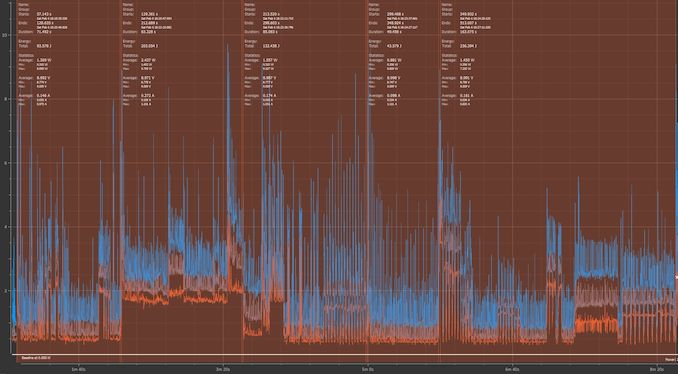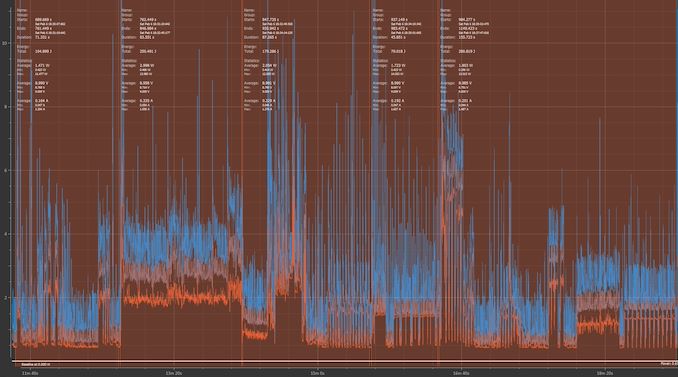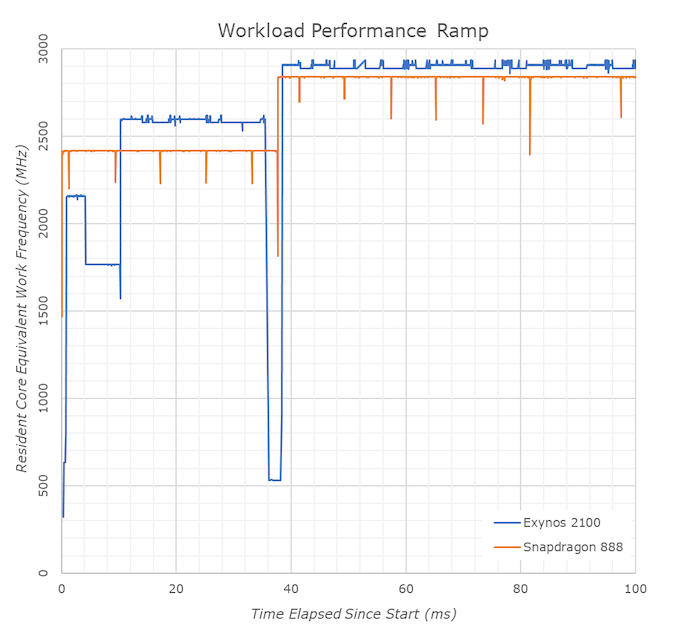The Snapdragon 888 vs The Exynos 2100: Cortex-X1 & 5nm - Who Does It Better?
by Andrei Frumusanu on February 8, 2021 3:00 AM EST- Posted in
- Mobile
- Samsung
- Qualcomm
- Smartphones
- SoCs
- Snapdragon 888
- Exynos 2100
Mixed-Usage Power & Preliminary Battery Life
We haven’t had both Galaxy S21 Ultra devices long enough to do our more extensive battery life testing routines, however I did run some more power analysis on the more compute-heavy PCMark suite as well as some battery life numbers at 120Hz.
I’ll start off with some power profiling – these figures are generally within 5% margin of error accurate in terms of power usage at the battery level but are measured as input power into device as this allows us much higher resolution data sampling, without actually dismantling the phones.
I put the devices to minimum brightness to minimise screen power attribution in the power figures, with the devices set to 120Hz mode and a lamp shining on them to enable the 120Hz VRR/LFD power savings on the display. Both devices are in their default performance modes.

Galaxy S21 Ultra - Snapdragon 888
The Snapdragon 888’s power chart looks relatively straightforward here, with the different sections corresponding to the different sub-tests in PCMark. We see a varied amount of activity with clear activity spikes and corresponding power spikes when the SoC had to do computations.
Instantaneous peak power is around the 9W mark, which should be mostly due to the Cortex-X1 cores of the chip running alongside the Cortex-A78 cores.

Galaxy S21 Ultra - Exynos 2100
The Exynos chart looks generally similar, which is no surprise given that it’s the same workload. What’s more interesting about the Exynos though is that it has much larger power spikes, up to 14W, which is notably more than the Snapdragon. The Cortex-A78 cores on the Exynos run much higher frequency and power than on the Snapdragon, and together with the higher power draw of the X1 cores, it makes sense that the Exynos’ instantaneous power is considerably higher when all the cores are under load.
The photo editing section of the test is very intriguing as the power profile is very different to that of the Snapdragon. This RenderScript section should be accelerated by the GPU, and here we see the Exynos’ baseline power goes up significantly compared to the Snapdragon for the majority of the test. This is almost 1W in magnitude – I really wonder what’s happening here under the hood and where that power comes from – maybe the GPU doesn’t have as fine-grained power gating or DVFS?
| Galaxy S21 Ultra Power Usage in PCMark Minimum Brightness, 120Hz, Default Performance Mode |
|||
| Snapdragon 888 Score - Power Usage |
Exynos 2100 Score - Power Usage |
% Difference Exynos vs Snapdragon |
|
| Idle Score Screen | 759mW | 797mW | +4.8% |
| Web-browsing | 12935 - 1309mW |
13159 - 1471mW |
+1.1% - +11.0% |
| Video Editing | 7866 - 2437mW |
6576 - 2998mW |
-16.4% - +18.7% |
| Writing 2.0 | 12966 - 1556mW |
15370 - 2054mW |
+18.5% - +24.2% |
| Photo Editing | 26884 - 881mW |
32385 - 1723mW |
+20.4% - +48.9% |
| Data Manipulation | 9918 - 1450mW |
8930 - 1803mW |
-10% - +19.6% |
Tabulating the PCMark test scores with the respective power figures across both Galaxy S21 Ultras, we see a few trends.
Performance wise, surprisingly enough, the Exynos has a few sub-tests where it outperforms the Snapdragon, notably in the Web-browsing, Writing and Photo editing tests. The Writing subtest particularly shows a +18% advantage in favour of the Exynos, while it loses more notably in the more single-threaded bound Data Manipulation test.
What’s also notable is that the Exynos’ power consumption is quite higher, across the board on all tests. The Photo Editing test aside where it has a 49% power disadvantage (which is actually high if we were to account for baseline device power), the rest of the test should be apples-to-apples CPU comparisons. We’re seeing roughly +15-20% device power disadvantages, and when account for baseline, this actually grows to around 18-35%. The Exynos does showcase a performance advantage in some of the tests, but not enough to make up for the increased power, meaning perf/W is lower.
Looking at the DVFS of the two chips, we see that they’re generally reaching peak performance at roughly the same time in around 37-38ms. The Snapdragon 888 will schedule a workload directly on the A78 cores at 2.41GHz during that time before ramping up to the X1 cores at 2.84GHz. The Exynos starts off on the A55 cores at idle frequencies around 400-624MHz for 900µs, ramping up to 2210MHz for 4.2ms, before migrating onto the Cortex-A78 cores which start at 1768MHz and ramp up to 2600MHz. Oddly enough, when migrating to the X1 cores the scheduler seems to have troubles migrating the load as the cores run at the idle 533MHz before realising they have work to do and ramp up to the maximum 2.91GHz.
What’s interesting about the Exynos here is that for single-threaded workloads it doesn’t actually visit the A78’s max frequencies – which is actually a benefit for power efficiency and makes the SoC behave more like the Snapdragon counterparts even though is has higher peak frequencies. What’s a bit concerning to see is that even in this extremely simplistic load which is just an add dependency chain, the X1 cores on the Exynos don’t look solid, but rather fluctuate quite a bit. The resulting 2888MHz readout actually doesn’t exist in the SoC’s frequency tables, so I have to wonder if that’s actually real, or if Samsung has employed some new sort of hardware DFS mechanism that works on extremely fine-grained timescales.

In terms of battery life in PCMark between the two phones, because we measured higher power draw on the Exynos, we naturally also see lower battery life on the new Samsung chip compared to the Snapdragon 888 variant of the S21 Ultra. The battery life here is tested in our traditional fashion, with the screen calibrated to 200cd/m² brightness.
The Snapdragon 888 S21 Ultra here fares better than the Galaxy S20 Ultra in terms of battery life, but by a quite minor amount. These results aren’t exactly great given the S21 Ultra’s massively more advanced and more efficient display.
For the Exynos 2100 S21 Ultra, the battery results here are actually slightly worse than the Exynos 990 S20 Ultra. This means that despite the new much more efficient screen, the Exynos 2100 is so aggressive in terms of performance scaling, that it draws notably more average power than the Exynos 990. Yes, the Exynos 2100 is also significantly more performant than its predecessor and this is immediately visible in terms of device usage, but it’s performance that wasn’t just achieved through efficiency, but also through more power usage.
We also got a smaller S21 with the Exynos 2100 – this variant as well as the S21+ do not have the new super-efficient OLED screen the S21 Ultra has, and as such the SoC’s more aggressive power draw is more prominently showcased through quite bad power efficiency in this test at 120Hz.

In the web-browsing test, which is less compute heavy and leans more towards display power consumption, both the new S21 Ultras fare significantly better than their predecessor due to the now much improved OLED display. These 120Hz numbers (at QHD no less), are actually fantastic, and just shows the new advancements of the new panel.
Nevertheless, the Snapdragon 888 variant of the S21 Ultra is still falling ahead of the Exynos 2100 version due to the better SoC efficiency and lower power levels. The 12.7% lead here is also similar to the general SoC efficiency differences we’ve seen in the other tests.
Update: February 14th - I'm retracting the 120Hz battery life results of the new VRR/LFD display devices pending re-testing, after discovering power-management inconsistencies in the test results. 60Hz results seem unaffected. Further details in the full review.
As we spend more times with the devices, we’ll be completing the test numbers at 60Hz as well as getting data from our web-browsing test. For the time being, the general view is that these new SoCs showcase quite increased performance, however their power draw has also gone up – meaning that battery life generationally should actually go down – with the exception of other non-SoC factors such as the S21 Ultra’s new more efficient display panel.











123 Comments
View All Comments
theblitz707 - Wednesday, February 10, 2021 - link
Dead by daylight too, its very demanding and you need a sdg865's gpu at least to have 60fps at high at all times, sdg855 is very good too just sometimes dip a bit below 60. And there is a gigantic visual difference between low and highUnashamed_unoriginal_username_x86 - Monday, February 8, 2021 - link
I don't think Andrei gets enough credit for his work here, he's put hours upon hours into methodical, detailed articles for a website that's been forced into sponsored posts to make ends meet. God freaking blessAlistair - Monday, February 8, 2021 - link
he always does the best, I'm eagerly awaiting the S21 review alsoFunBunny2 - Monday, February 8, 2021 - link
"God freaking bless"one might wonder where all that revenue goes? could it be the corner office Suits?
Spunjji - Monday, February 8, 2021 - link
I don't think it's actually that much revenue TBHtuxRoller - Monday, February 8, 2021 - link
Ugh. I'm extremely curious as to how much of a deal slsi have qcom.The "dark horse" (in the west/outside China) huawei looks like they out did themselves. Damn good job
Fulljack - Monday, February 8, 2021 - link
probably because 80% capacity of TSMC 5nm are reserved for Apple A14 and M1, so Qualcomm won't bother with that 20% anyway.tuxRoller - Tuesday, February 9, 2021 - link
20% for their top end socs might be about right.Last year, at least, they were already splitting their orders between fabs.
tkSteveFOX - Monday, February 8, 2021 - link
As expected due to Sammy's inferior fab node it's almost pointless to upgrade your SD865/+ device if not for a slightly better camera experience, but is too highly debatable.As a owner of a Sony 1 II I am perfectly willing to skip this generation entirely and wait for TSMCs 5nm to become widely available to Qualcomm and most noticeably, wait to see what chip Huawei can produce end of year to replace Kirin (still thinking they will acquire MTK at some point this year)
tuxRoller - Tuesday, February 9, 2021 - link
I thought there was talk of huawei selling their smartphone brands (mate & p, I think)? I recall huawei denying it but the source who made the claim apparently also made a previous claim regarding huawei, and which Huawei also denied, that turned out to be correct